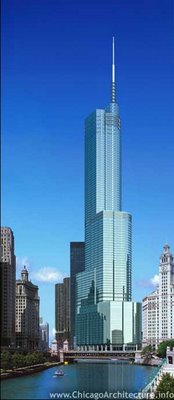 Also Known As: Trump Tower Chicago
Also Known As: Trump Tower ChicagoDesigned by: Skidmore, Owings, and Merrill
Construction Start: 2005
Construction Completed: 2008
Cost: $750,000,000.00
Type: Skyscraper
Stories: 92
Maximum Height: 1,131 feet / 345 meters to the roof, 1,362 feet / 415 meters to tip of the spire.
(including spires, antennae, etc...)
Location: 401 North Wabash
Area: Near North Side
Post Code: 60611
City: Chicago, Illinois
It's been a long time since Chicago had a new megatower punctuate the skyline. The 1960s saw the Hancock Center rise into the sky. In the 1970s it was the Sears Tower and the Aon Center. Then following the economically turbulent turn of the century, real estate mogul and international showman, Donald Trump stepped up to the plate with a plan to replace the dowdy 1950s Sun-Times building with a 90-story tower bearing his name. At first there was much excitement as The Donald's organization made the announcement. But that evaporated into disappointment in 2001 when the first sketches came out. It showed a multi-tiered silver-glass giant that didn't so much soar into the sky as squat along the Chicago River. Simply put, it was too wide, not majestic, and made a mockery of its architectural neighbors – the Wrigley Building, the Jewelers Building, and the Tribune Tower. A subsequent revision in 2002 by Adrian Smith was a significant improvement. It definitely fit in with the city's recent architectural trend of putting illuminated spires on everything. But alas, it looked a lot like the beloved, yet time-worn Sears Tower. This was primarily because of the use of stacked boxes. Even though they were not square, but octagons and hexagons, the design seemed too familiar. The third time was the charm. The latest edition of the plan drops the angles in favor of curves, and masses the sections in such a way as to evoke the sense of a steaming ship of commerce plowing through the city. It's the same sense one gets from looking at the Wrigley Building next door from the correct angles. The Trump Tower Chicago makes great use of its available space while creating another icon in the city's skyline. Moreover, its setbacks pay homage to the Art Deco-era skyscrapers that made Chicago a living architectural museum. And it manages to reach for the stars without stepping on its neighbors. In fact, to its neighbors, it will appear to be an equal. That's because the first setback is at the same height as the cornice on the Wrigley Building, the second is the same height as Marina City, and the third is at the top of the IBM Building across the street.
No comments:
Post a Comment